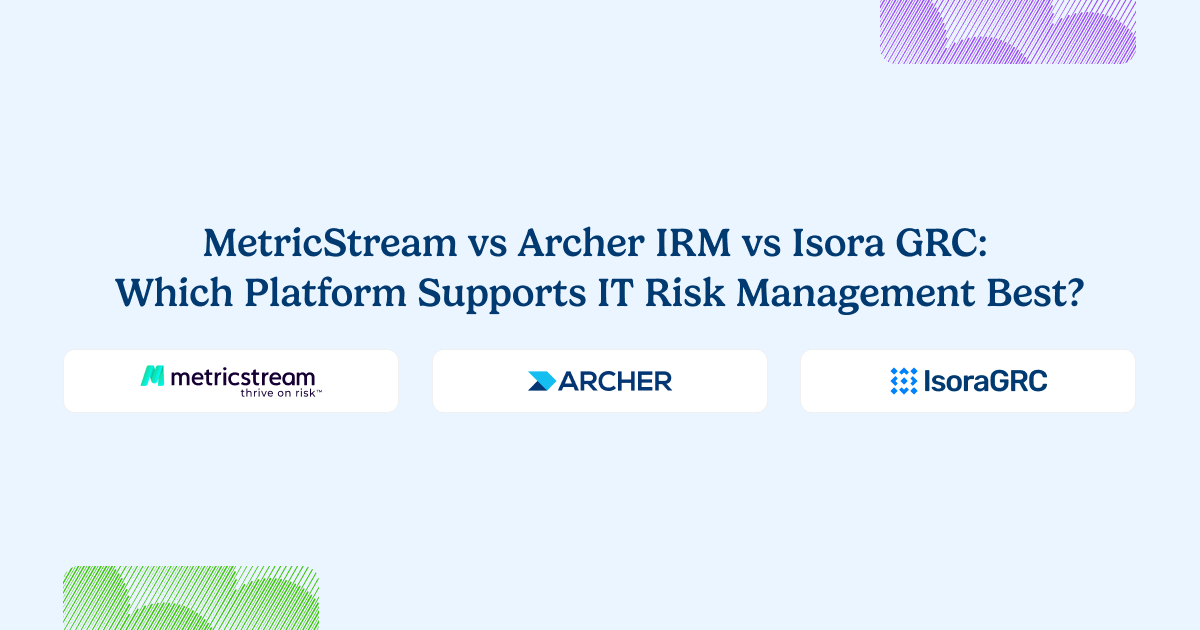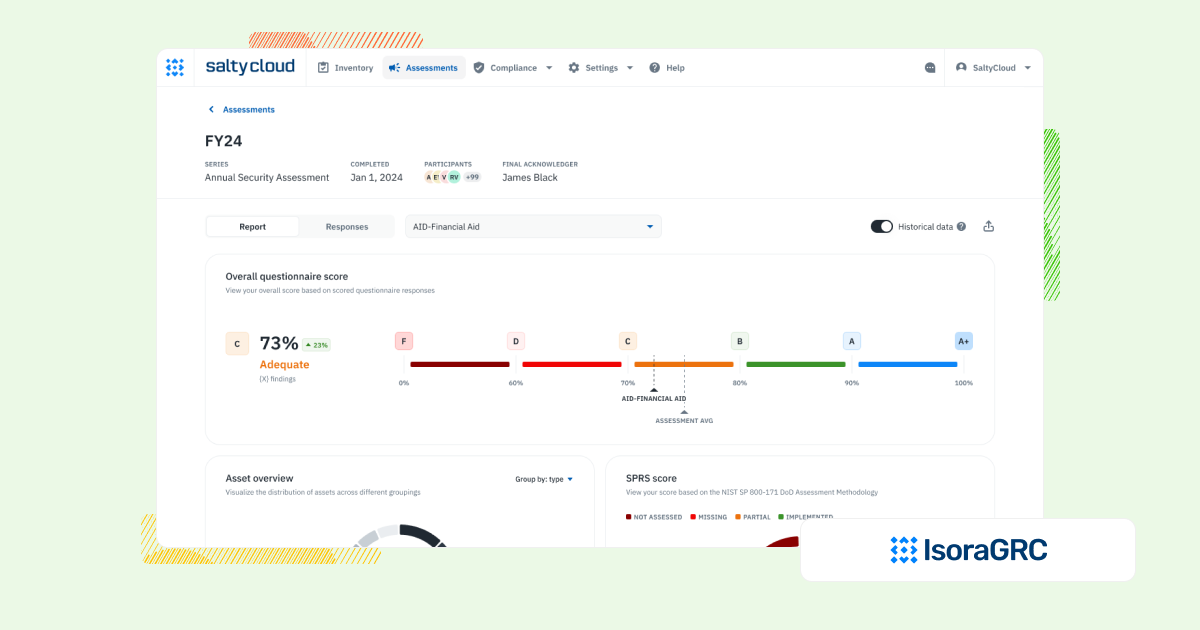
Every security team needs a structured, collaborative way to manage IT risk—without getting buried in complexity.
Platforms like MetricStream and Archer IRM are part of a class of all-in-one GRC tools built to support enterprise-wide governance. They offer broad functionality across compliance, audit, and enterprise risk, but for security teams, they often introduce more friction than flexibility.
When a platform tries to do everything, it rarely works well for the people doing the day-to-day work. Heavy implementation, poor usability, and slow adoption make these tools hard to justify—especially for teams focused on risk assessments, inventories, and remediation.
Isora GRC takes a different approach. It’s purpose-built for security teams, making it easy to run assessments, track risks, manage exceptions, and engage stakeholders across your organization—all without the overhead of traditional GRC platforms.
Let’s take a closer look.
Choosing the Right Platform for IT Risk Management
MetricStream and Archer IRM are well-known platforms in the GRC space—but they were built for broad governance needs, not the specific realities of managing information security risk. They prioritize configurability across departments, which often leads to months-long implementations, complex interfaces, and workflows that don’t reflect how security teams actually operate.
Isora GRC is different. It was purpose-built for information security risk management and third-party risk management—offering structured, repeatable workflows for assessments, inventories, risk registers, and exception tracking. It’s fast to deploy, intuitive to use, and easy for anyone in the organization to adopt, so security teams can focus on managing risk—not managing the platform.
The Workflow That Matters: Managing IT Risks and Compliance
Managing IT risk isn’t a quarterly project—it’s a continuous process that relies on cross-functional collaboration. Security teams need to assess internal departments and third parties, manage inventories of systems and vendors, track exceptions, and document risks as they emerge. But none of that works without clear workflows and broad participation.
Most legacy tools weren’t built with that in mind. Managing risk with a bloated GRC platform often means juggling disconnected modules, configuring workarounds, or relying on other teams just to keep the process moving. That slows everything down—and makes it harder to stay ahead of what matters.
How Each Platform Supports IT Risk Management Workflows
| Workflow Area | MetricStream | Archer IRM | Isora GRC |
| Assessment Management | Complicated assessment workflows requiring significant technical setup. Supports frameworks like ISO 27001 and NIST CSF but needs extensive configuration through AppStudio. | Document-driven approach with complex approval workflows. Requires specialized resources and extensive professional services to implement properly. | Centralized, intuitive assessment dashboard across business units, vendors, and assets. Built specifically for security teams. |
| Questionnaire Delivery & Completion | Questionnaires not a primary feature. Focuses on technical assessments rather than user-friendly surveys, requiring technical staff for implementation. | Limited questionnaire capabilities that require extensive configuration. Not designed for end-user completion, requiring technical mediators. | Customizable and prebuilt questionnaires for frameworks like NIST, ISO, GLBA, HIPAA, and more. Designed for internal and external collaboration. |
| Inventory Tracking | Centralized repository for assets and threats but requires complex mapping configurations and manual input for many processes. Limited integration capabilities. | Extensive asset and entity management requiring specialized setup and ongoing maintenance. Complex hierarchies that are difficult to navigate and maintain. | Centralized tracking of assets, vendors, and organizational units with integration support for existing data sources. |
| Risk Register & Exception Management | Risk register available with complex configuration options. Exception handling through rigid workflows that require technical setup through AppStudio. | Advanced risk register requiring specialized knowledge with formal signoff processes that create bottlenecks. Exception governance managed through multiple modules requiring integration. | Flexible, collaborative risk register with scoring, status, evidence, and ownership tied directly to assessments. Exception management is built-in and intuitive—no extra modules or configuration required. |
| Scoring, Reporting & Risk Visualization | Advanced reporting with heat maps but requires manual configuration for executive use. Reports often require technical expertise to create and modify. | Powerful but complex reporting capabilities requiring significant consultant hours to set up. Difficult to modify without specialized knowledge. | Automated scorecards, risk maps, and executive-friendly reports with actionable insights—no manual config required. |
| Collaboration & User Experience | Complex interface requiring significant training. Collaboration enabled through centralized data sharing but not emphasized as a core feature. | Steep learning curve with overwhelming interface. Collaboration through “Archer Engage” but lacks intuitive discussion tools. Most users need extensive training. | WCAG-compliant, award-nominated interface with built-in commenting, team workflows, and fast onboarding. |
| Implementation & Setup | Implementation typically takes months with significant configuration through AppStudio. High expertise requirements for setup and ongoing maintenance. | Implementation typically takes months to years with specialized resources. High total cost of ownership with significant consulting and internal resource requirements. | No-code setup in days or weeks. Minimal IT lift required. Designed to go live quickly across teams and vendors. |
What Sets Isora GRC Apart?

Isora GRC was purpose-built for information security teams—designed to support the real workflows behind risk and compliance, not just generate reports. While legacy GRC platforms require months of configuration and rigid processes, Isora takes a modern, scalable approach:
- Purpose-built for security and third-party risk teams
- No extra modules or cross-department bloat—just the workflows that matter.
- Easy for anyone to use
- Clean UI, no complex training, and built to drive adoption across the org.
- Streamlined for action, not just documentation
- Assessments, questionnaires, inventories, risk tracking, and reporting—all in one place.
- Fast, no-code implementation
- Go live in weeks, not quarters, with minimal IT lift.
- Scales with your program
- Whether you’re running a lean risk function or supporting a large institution, Isora grows with you—without getting in the way.
Who Each Platform Is Best For
| Platform | Who It’s For |
| MetricStream | Enterprises with multiple departments looking to manage governance, compliance, and risk in one place. Powerful, but often feels heavy, complex, and difficult to adopt—especially for security teams. |
| Archer IRM | Large organizations in finance or government that need highly customized risk tools to meet strict regulatory and audit requirements. Built for scale, but requires significant configuration and ongoing maintenance. |
| Isora GRC | Security teams that need a scalable, usable IT risk management program across their organization. |
What Our Customers Say About Isora GRC
Security teams at top institutions are using Isora GRC to replace legacy tools and manual processes with intuitive workflows and actionable insight.
“Moving from manual processes to using Isora was a breath of fresh air. What used to take months is now automated, reliable, and defensible. Isora saves us significant time while delivering accurate insights that improve decision-making.”
Jessica Sandy, IT GRC Manager, The University of Chicago
“Isora has been essential in helping us meet our University of California cybersecurity requirements across a decentralized campus. Automating assessment data collection and reporting has given us clear visibility into unit-level risks, enabling us to prioritize resources effectively and address gaps with confidence.”
Allison Henry, CISO, The University of California, Berkeley
FAQs
What’s the difference between MetricStream, Archer IRM, and Isora GRC?
MetricStream and Archer IRM are all-in-one GRC platforms designed for enterprise-wide governance programs. Isora GRC focuses specifically on IT and vendor risk management, giving security teams a streamlined, scalable way to manage assessments, inventories, risks, and exceptions—without the complexity of traditional GRC tools.
Are MetricStream and Archer IRM considered all-in-one GRC tools?
Yes. These platforms offer broad coverage across compliance, audit, risk, and privacy functions. But that breadth often leads to heavy configuration, slow implementation, and limited usability for security teams focused on risk assessments and remediation workflows.
Does Isora GRC replace tools like MetricStream or Archer IRM, or does it complement them?
For teams focused on IT and third-party risk, Isora GRC can fully replace traditional GRC platforms. Some large organizations may still use enterprise GRCs for broader governance functions, but security teams often adopt Isora to improve usability, reduce overhead, and drive adoption.
Which platform is best for managing IT risk across an organization?
If your focus is on running assessments, tracking risks, and maintaining inventories across business units or vendors, Isora GRC offers a purpose-built, easy-to-use alternative. It helps security teams operationalize risk management in ways legacy GRC platforms struggle to support.
Do I still need an all-in-one GRC tool if I use Isora GRC?
Not necessarily. Isora GRC covers the core capabilities security teams rely on: assessments, questionnaires, inventories, risk tracking, and reporting. Many organizations adopt Isora as a standalone platform to replace bloated or underused GRC tools.
What should I look for in a GRC platform for information security teams?
Look for ease of use, workflow coverage, and fast implementation. The best platforms support assessment management, questionnaire delivery, risk registers, exception tracking, and inventory management—all in a way that drives participation across technical and non-technical users.
How does Isora GRC support teams managing both internal and vendor risk?
Isora GRC supports both use cases out of the box. Teams can run internal assessments, collect data from vendors, track risks and exceptions, and maintain centralized inventories—all within the same platform.
Can Isora GRC help with frameworks like NIST, GLBA, or HIPAA?
Yes. Isora GRC supports structured assessments and reporting across multiple compliance frameworks, including NIST 800-53, GLBA, HIPAA, ISO 27001, and others.



















 Other Relevant Content
Other Relevant Content